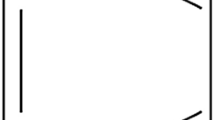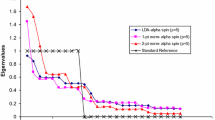Abstract
As an alternative to the variational constrained density functional theory a simpler perturbative approach based on the Taylor series expansion, around the ground state of the system, of the density matrix and the electronic density, as functions of the Lagrange multiplier, introduced to impose the constraint in the variational procedure, is developed and implemented in deMon2k. The first and second order corrections introduced are evaluated with the information contained in the ground state calculation, through the use of auxiliary density perturbation theory, while the value of the Lagrange multiplier at which the series is evaluated is determined from the amount of charge transferred. The energy differences between the ground and the constrained states obtained with the first and second order perturbative terms lie, in general, close to the variationally determined values. In addition, it is found that the results are practically independent of the exchange–correlation energy functional used and show rather small variations with respect to the basis set.

Similar content being viewed by others
References
Kohn W, Sham LJ (1965) Phys Rev 140:1133–1138
Hohenberg P, Kohn W (1964) Phys Rev B 136:B864–B871
Parr RG, Yang WT (1989) Density-functional theory of atoms and molecules. Oxford University Press, New York
Wu Q, Van Voorhis T (2005) Phys Rev A 72:024502
Wu Q, Van Voorhis T (2006) J Chem Theory Comput 2:765–774
Segal M, Singh M, Rivoire K, Difley S, Van Voorhis T, Baldo MA (2007) Nat Mater 6:374–378
Evans JS, Cheng CL, Van Voorhis T (2008) Phys Rev B 78:165108
Wu Q, Kaduk B, Van Voorhis T (2009) J Chem Phys 130:034109
de la Lande A, Salahub DR (2010) J Mol Struct Theochem 943:115–120
Van Voorhis T, Kowalczyk T, Kaduk B, Wang LP, Cheng CL, Wu Q (2010) Annu Rev Phys Chem 61:149–170
Difley S, Van Voorhis T (2011) J Chem Theory Comput 7:594–601
Kaduk B, Kowalczyk T, Van Voorhis T (2012) Chem Rev 112:321–370
Rezac J, Levy B, Demachy I, de la Lande A (2012) J Chem Theory Comput 8:418–427
Yost SR, Lee J, Wilson MWB, Wu T, McMahon DP, Parkhurst RR, Thompson NJ, Congreve DN, Rao A, Johnson K, Sfeir MY, Bawendi MG, Swager TM, Friend RH, Baldo MA, Van Voorhis T (2014) Nat Chem 6:492–497
de la Lande A, Gillet N, Chen SF, Salahub DR (2015) Arch Biochem Biophys 582:28–41
Ma PW, Dudarev SL (2015) Phys Rev B 91:054420
Mangaud E, de la Lande A, Meier C, Desouter-Lecomte M (2015) Phys Chem Chem Phys 17:30889–30903
Rezac J, de la Lande A (2015) J Chem Theory Comput 11:528–537
Gillet N, Berstis L, Wu XJ, Gajdos F, Heck A, de la Lande A, Blumberger J, Elstner M (2016) J Chem Theory Comput 12:4793–4805
Turban DHP, Teobaldi G, O'Regan DD, Hine NDM (2016). Phys Rev B 93:165102.
Holmberg N, Laasonen K (2017) J Chem Theory Comput 13:587–601
Carmona-Espíndola J, Flores-Moreno R, Köster AM (2010) J Chem Phys 133:084102
Shedge SV, Carmona-Espíndola J, Pal S, Köster AM (2010) J Phys Chem A 114:2357–2364
Calaminici P, Carmona-Espíndola J, Geudtner G, Köster AM (2012) Int J Quantum Chem 112:3252–3255
Carmona-Espíndola J, Flores-Moreno R, Köster AM (2012) Int J Quantum Chem 112:3461–3471
Shedge SV, Pal S, Köster AM (2012) Chem Phys Lett 552:146–150
Geudtner G, Calaminici P, Carmona-Espíndola J, del Campo JM, Dominguez-Soria VD, Flores-Moreno R, Gamboa GU, Goursot A, Köster AM, Reveles JU, Mineva T, Vasquez-Perez JM, Vela A, Zuñiga-Gutierrez B, Salahub DR (2012) Wiley Interdiscip Rev Comput Mol Sci 2:548
Handy NC, Tozer DJ (1998) Mol Phys 94:707–715
Becke AD (1988) Phys Rev A 38:3098–3100
Lee CT, Yang WT, Parr RG (1988) Phys Rev B 37:785–789
Becke AD (1993) J Chem Phys 98:5648–5652
Becke AD (1993) J Chem Phys 98:1372–1377
Stephens PJ, Devlin FJ, Chabalowski CF, Frisch MJ (1994) J Phys Chem 98:11623–11627
Hehre WJ, Ditchfield R, Pople JA (1972) J Chem Phys 56:2257–2261
Harihara PC, Pople JA (1973) Theor Chim Acta 28:213–222
Zhao Y, Truhlar DG (2006) J Phys Chem A 110:13126–13130
Calaminici P, Janetzko F, Köster AM, Mejía-Olvera R, Zúniga-Gutiérrez B (2007) J Chem Phys 126:044108
Hirshfeld FL (1977) Theor Chim Acta 44:129–138
Köster AM, Flores-Moreno R, Reveles JU (2004) J Chem Phys 121:681–690
Perdew JP, Burke K, Ernzerhof M (1996) Phys Rev Lett 77:3865–3868
Dunning TH (1989) J Chem Phys 90:1007–1023
Dirac PAM (1930) Proc Camb Philos Soc 26:376–385
Vosko SH, Wilk L, Nusair M (1980) Can J Phys 58:1200–1211
Carmona-Espíndola J, Gázquez JL, Vela A, Trickey SB (2015) J Chem Phys 142:054105
Adamo C, Barone V (1999) J Chem Phys 110:6158–6170
Ernzerhof M, Scuseria GE (1999) J Chem Phys 110:5029–5036
Adamo C, Scuseria GE, Barone V (1999) J Chem Phys 111:2889–2899
Flores-Moreno R, Koster AM (2008) J Chem Phys 128:134105-1–134105-10
Flores-Moreno R, Carmona-Espíndola J, Köster AM (2015) AIP Conf Proc 1642:60–68
Diercksen G, McWeeny R (1966) J Chem Phys 44:3554–3560
McWeeny R (1968) Chem Phys Lett 1:567–568
McWeeny R, Diercksen G (1968) J Chem Phys 49:4852–4856
Acknowledgements
We thank the Laboratorio de Supercómputo y Visualización of Universidad Autónoma Metropolitana-Iztapalapa and the Laboratorio Nacional de Cómputo de Alto Desempeño (LANCAD) for the use of their facilities. We thank Conacyt for grant sinergia 1561802.
Author information
Authors and Affiliations
Corresponding author
Additional information
Publisher's Note
Springer Nature remains neutral with regard to jurisdictional claims in published maps and institutional affiliations.
Published as part of the special collection of articles “20th deMon Developers Workshop”.
Appendix: Implementation in deMon2k of the first and second order corrections to the density matrix
Appendix: Implementation in deMon2k of the first and second order corrections to the density matrix
In order to describe the main aspects of the first and second order perturbation corrections to density matrix and to the electronic density, we will make use of a matrix language, since its implementation is done in a developer version of deMon2k [27] that is based on a Gaussian basis set.
Thus, to obtain the first order perturbed density, we use ADPT [22,23,24,25, 48, 49]. In this approximation the first order density is obtained through the McWeeny self-consistent perturbation theory [50,51,52],
where the sum over \(i\) corresponds to the occupied molecular orbitals, while the sum over \(a\) corresponds to the unoccupied ones. In ADPT the first order Kohn–Sham matrix is obtained with the following expression,
where
\(x_{{\overline{k} }}^{{\left( \lambda \right)}}\) is the \(k{\text{th}}\) element of the first order auxiliary density, \(f_{{\overline{l} \overline{m} }}\) represents the integral of the second variational derivative of the exchange–correlation functional with two auxiliary functions \(l\) and \(m\).
For the particular case of this new perturbation, we solved the ADPT equations as made in previous work [22,23,24,25, 48]
where \({\mathbf{F}} = {\mathbf{G}}^{{ - 1}} {\mathbf{f}}\), \({\mathbf{G}}^{{ - 1}}\) is the inverse of the Coulomb matrix \({\mathbf{G}}\), and the elements of the Coulomb coupling matrix can be expressed as
The elements of the perturbation vector \({\mathbf{b}}^{{\left( \lambda \right)}}\) contain the explicit form of the perturbation, that is
Once the first order auxiliary density coefficients have been obtained by solving Eq. (33), the first order Kohn–Sham matrix, Eq. (31), can be evaluated, and with this one, the first order density matrix can be determined.
Now, in the framework of ADPT the explicit form of the second order perturbed density matrix is given by [25, 49]
This expression was derived to obtain third derivatives in the energy, required for the calculation of first hyperpolarizabilities. However, it was not implemented in its explicit form, because the Wigner’s 2n + 1 rule allowed to calculate third derivatives of the energy in terms of first order densities. Here we illustrate how the implementation of the explicit form of Eq. (36) was performed to obtain second order densities. The first term in the right-hand side of this expression depends on the following first order densities,
Now, in order to simplify the explicit form of these matrices, one can introduce the transformation matrix,
and its transpose, as
The occupied-occupied block of Eq. (37) is expressed as follows in terms of this transformation matrix,
where \({\mathbf{S}}\) corresponds to the overlap matrix. The unoccupied-unoccupied block is calculated as
while the occupied-unoccupied block is given by
Here, \({\mathbf{c}}_{i}^{{}}\) is a vector whose elements are the coefficients of the molecular orbital \(i\), equivalently for \({\mathbf{c}}_{a}^{{}}\), and
and the unoccupied-occupied block of Eq. (37) is given by
Now, the second term of Eq. (36) depends on the second order Kohn–Sham matrix, which can be expressed as
where \({\mathbf{x}}^{{\left( {\lambda ,\lambda } \right)}}\) depends on first order densities,
and \(g_{{\overline{l} \overline{m} \overline{n} }}\) is the integral of the third variational derivative of the exchange–correlation functional with three auxiliary functions \(l\), \(m\) and \(n\).
In the calculation of first hyperpolarizabilities, this third variational derivative was integrated with three first order densities. The second order auxiliary coefficients, \({\mathbf{x}}^{{\left( {\lambda \lambda } \right)}}\), are obtained by solving the system of equations,
with
Thus, after solving Eq. (47) one can obtain the explicit elements of the second order Kohn–Sham matrix, Eq. (45), and once the second order density matrix is determined, one can incorporate the first and second order corrections to the density.
It is important to note that the present derivation is limited to the local density (LDA) and generalized gradient (GGA) approximations to the exchange–correlation energy functionals, since in the case of hybrid functionals with a fraction of exact exchange, one would have to include additional terms for the calculation of the first and second order perturbation corrections that have not been considered in the previous equations.
A relevant aspect of the present approach is that it may be readily implemented in any code that includes the calculation of polarizabilities and hyperpolarizabilities, through simply replacing the electric field by the term associated to the constrained charge transfer, \((w_{{Ac}} ({\mathbf{r}}) - w_{{Do}} ({\mathbf{r}}))\), which is what we did to arrive at Eqs. (31) and (35).
Rights and permissions
About this article
Cite this article
Carmona-Espíndola, J., Gázquez, J.L. Perturbation approach to constrained electron transfer in density functional theory. Theor Chem Acc 140, 96 (2021). https://doi.org/10.1007/s00214-021-02798-x
Received:
Accepted:
Published:
DOI: https://doi.org/10.1007/s00214-021-02798-x




